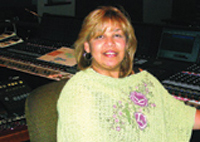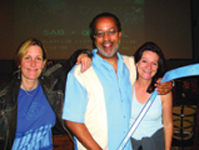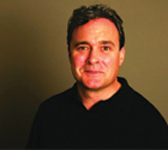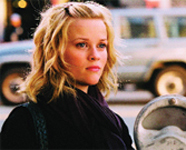In Just Like Heaven, "Reese Witherspoon is a ghost, she's transparent, and [the director's] admonition was to make it the sound of molecules colliding," explains Technicolor Sound Services' sound designer, Mark Mangini. "That's the kind of thing we hear in the field. How do you interpret that into a real, audible sound? In a traditional sound design realm I had to create the sound of nothingness."

Freelance ADR supervisor Bobbi Banks, who worked on Fox Searchlight's Roll Bounce, spent a lot of time recording and recreating sounds of the crowd within the roller rink.
|
What made that challenge easier for Mangini, and what's most interesting about the work he did on Just Like Heaven, was the fact that he was embedded with the director [Mark Waters], picture editor [Bruce Green] and the visual effects department in an office at Universal Studios. "As they were cutting the picture, they could feed me sequences and I could create sounds, environments and atmospheres, feed them back to the editor and have that be an interactive process that would hopefully inform their edit," he reports. "That also gave us the particular advantage of building the soundtrack on a day-by-day or week-by-week basis as we went, so as we approached the preview process as well as the final mix process, we were in very good shape."
Mangini received QuickTime movies and OMFs from the visual team and also had digitized production audio to work on as he received picture. "I would design sequences in my little design/mix suite and feed them back AIFF stereo mix downs," he explains. He worked on a Macintosh G5 running Digidesign Pro Tools with "every plug-in imaginable," Pro Control, a MIDI keyboard and Net Mix, a sound effects library browser that he's been designing with Technicolor for the past two years.
IT'S ALIVE

Made sure the sounds in Four Brothers (above) matched the real sounds of the city where film was set: Detroit.
|
The names Johnny Knoxville, Jessica Simpson, Burt Reynolds and Seann William Scott might get the big print on the Dukes of Hazzard poster, but it's the General Lee that gets the most oohs and ahs. So, LA-based sound designer Greg King of Sound Dogs (www.sounddogs.com/), which also has studios in Toronto, immediately got to work finding the right sound to bring to the scenes with the famous Dodge Charger. The first problem was that of the 23 General Lees that were on the shoot, only one of them had the Dodge Hemi engine that's recognized as the sound of the car, and that one was the car used in non-action shots.
So, King and the team at Sound Dogs, who also worked on the dialogue and ADR for the film, searched around until they found just the right car in a city about 70 miles northeast of Las Vegas. "The owner of the car was fine with us driving it hard, because the engine was in good shape, but the bodywork hadn't been completed," King explains. A team of four from Sound Dogs - King, Rob Nokes, Yann Delpuech and Darren King - got to work recording the Charger. The exterior tracks were recorded into a Sonic Devices 722 digital hard disk recorder and a pair of Fostex FR-2s through either a Neumann 190I or a Neumann 191 microphone.

Danetracks' Greg Hedgepath, flanked by Foley artists Robin Harlan and Sarah Monat (L-R).
|
Onboard tracks were recorded via another FR-2 with a Crown PZM mic in the engine compartment and a Sennheiser e835, which is a dynamic vocal mic, but King says, "Because these engines are so percussive and have so much low end and kick to them, especially at the exhaust end, a dynamic mic worked better. We took those two microphones and mixed them together, because the engine compartment has a lot of high end and the back has all the low end, and we came up with our sound."
Rather than getting some sounds and then manipulating them in post production, King says it was crucial this time around to get the correct sounds in the field. "Especially with something like a car that's a character in the movie. It's something that we had to capture in the recording and performance. When we recorded the car we did all these things to make it seem like the car was alive, like revs and accelerations, decelerations and dropping the car into gear unnaturally to make it make certain sounds so that later we could edit it to give it character." That said, the editorial work was done in Pro Tools and a system was on hand during the mix for any last minute fixes. The final mix was done at Warner Bros.
SOUNDS OF THE CITY

Warner Bros. Kim Waugh: "The industry has pressured people to work a little differently, but there's never been as much talent as there is today."
|
Greg Hedgepath was concerned with making sure the sounds of Four Brothers matched the visuals, down to the smallest detail. "We're using actual Detroit ambiances recorded there to try to give a feel of the city," explains the Danetracks (www.danetracks.com/) supervising sound editor. "Even though I've been there, I had to talk to people who had really spent time there. They could tell me things like in certain parts of the city you always hear trains or construction sounds, or in certain areas you would never hear traffic because it's almost deserted. So, we were even careful about just the air that we used in a certain part of the city."
The audio team was also cognizant of the snow that was on the ground, and they had to go out and record extra tracks in the Mammoth Mountains, east of Los Angeles, for a couple of car chase scenes. "We miced up two different cars on the front and rear tires and we were careful not to mic near the tail pipe because we did not want to get the engine sound. We just wanted to get the sound of the tires spinning and locking up and skidding," Hedgepath explains. Exterior tracks were recorded into a Zaxcom Deva hard disk recorder through a Neumann RSM-191 stereo shotgun mic. The on-board microphones were a pair of Neumann KM 100s with hypercardioid capsules.

Technicolor's Mark Mangini created the sound of a ghost for the upcoming DreamWorks release Just Like Heaven.
|
As if that wasn't enough, Hedgepath, who did the final mix at Warners, wanted to make sure the gun sounds were powerful and accurate. "There are a couple of gun battle scenes, and one of them is a five-minute onslaught where some bad guys show up and the brothers do battle with them," he describes. "We were really working hard to get the sound of the guns to sound big, but real. So, many of the gun elements are six elements deep to give us enough variation on the dub stage so that we could really tweak them. What I intend to do when we mix them is, instead of tweaking them with EQ, bring up an element or lower an element and use that to change the tone of the gun
CABIN FEVER
In Flightplan, a woman's daughter goes missing at 30,000 feet. "As the walls are closing in on Kyle [Jodie Foster's character] our challenge was finding ways to underscore that experience sonically," explains Soundelux (www.soundelux.com/) supervising sound editor Dave McMoyler of his work on Flightplan. "We kind of have a two-pronged attack for that, one is there's an internal level sonically, and then there's an external level. As she starts to feel the pressure mounting, we're doing things with the actual sounds of the aircraft." That includes using a variety of sounds, from the plane's turbine whines to the hydraulic servo system to "the roar of the fuselage against the atmosphere outside.
"I'm trying to find a way to almost anthropomorphize the servos in such a way that we want to make the plane a character," McMoyler continues. "We want the plane have an emotional quality, and one of the things I'm experimenting with is we've got some little moans and whimpers from the actress who played her daughter that we're going to try to fold in there subliminally. So, as she's trying to find this lost daughter you almost get the sense that the plane is talking to her. Of course it's going to be very delicate."
Balancing the external sounds, McMoyler adds, plays into the internal levels of Foster's character. "That's going to involve actually stripping sound away. What we're going to try to do at key moments, when the pressure is really building on Kyle, will be to just get inside her head. And there might be one element that she'll hear, whether it's the overhead air blower that she hears and everything else goes away, or it might be the sound of a program or some music coming through one of the other passenger's headsets. But, there will be times where, because she is so intent on finding her daughter, she'll get fixated on one sonic element that is happening in the cabin."
The film is being cut entirely on Pro Tools, and aircraft interiors, servos and location backgrounds were recorded using the Edirol R-1 portable flash recorder with an Audio Technica AT815 microphone and a TASCAM DAP-1 DAT recorder with a Neumann stereo microphone. "To create weird vocal and breath design effects, to help add subliminal character to the plane, my lead designer, Jon Title, used Reason's NN-XT Sampler and Vocoder programs," McMoyler explains. "We augmented the modulation of the plane interiors to convey altitude changes or simply add pressure to a given scene using the Lexicon PCM-80, and used the GRM Doppler Pro Tools plug-in for plane bys and extreme point of view treatments."
WORKING THE RINK
It's one thing to match dialogue tracks that were recorded in a car or a bedroom, and quite another when the scene calls for matching tracks recorded in a roller skating rink, as was the case with Fox Searchlight's Roll Bounce. As if that wasn't enough, explains freelance ADR supervisor Bobbi Banks, "we had to blend between the skaters, the crowds and the actual skates themselves to make it exciting."
To get the right crowd sounds, Banks and the team recorded group dialogue tracks where the talent would stand still and either a Neumann RSM 191 stereo shotgun mic or a Neumann U-87 would whoosh by them. The goal was to make it sound like the skaters were skating by a crowd who was cheering for them. "It was pretty cool, and we had to layer those so it sounded a little more authentic," she says. All of the tracks were recorded into Pro Tools.
In addition to those group tracks, Banks explains "there were some guys that went into the rink and recorded some people yelling [from that perspective]. We used a little bit of that to get a more realistic sound."
Banks, who took over the position of the president of the Motion Picture Sound Editors organization at the beginning of August, sees that sound pros are being impacted more and more by compacting schedules. "For example, we'll be mixing and we'll also be temping on another stage, so it's making our jobs much more difficult. Even on Roll Bounce we were pre-dubbing and temping and I was shooting ADR, then they started going to the final mix and I was shooting ADR. It's really hard for us as professionals that we get the quality that's needed for each film in the time allotted. Sometimes we have less people on the crew that we [would have in the past] because of the budgets, and it's really hard for us to pump out the quality," she says. "We don't ever want to compromise on the sound of a film."
Banks was working at Warner Bros. during her time on Roll Bounce.